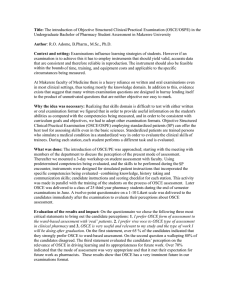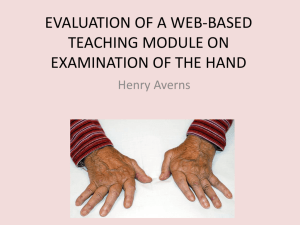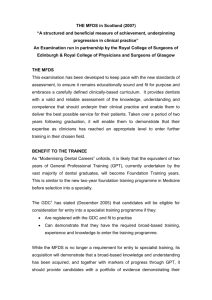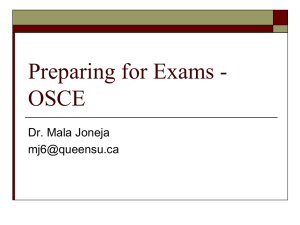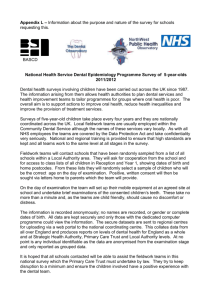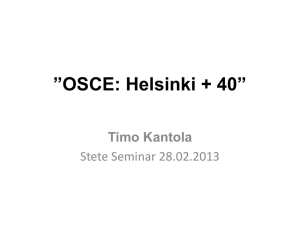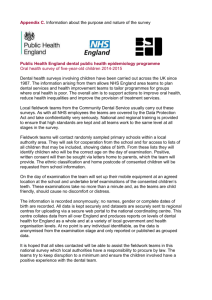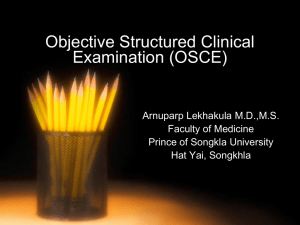The OSCE - Boston University
advertisement
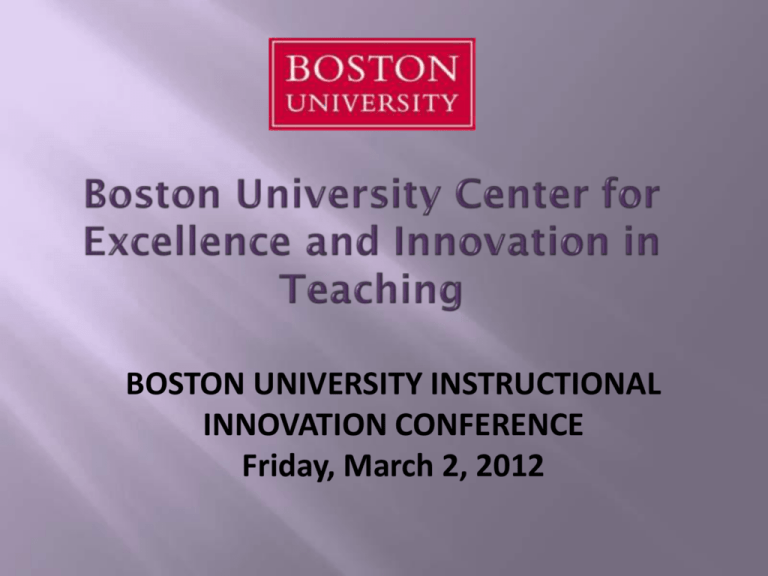
BOSTON UNIVERSITY INSTRUCTIONAL INNOVATION CONFERENCE Friday, March 2, 2012 Presented By: Mark S. Ferriero, BA, DDS, MAGD Clinical Associate Professor Boston University Henry M. Goldman School of Dental Medicine Department of General Dentistry ferriero@bu.edu Purely objective exams (e.g. case-based or context-free MCQs) have been a constant, a staple in education for decades. In clinically-oriented educational environments (e.g. medical, dental, pharmacy, PT), additional/adjunct testing styles are quite beneficial, even necessary for success. OSCE (Objective Structured Clinical Examination) testing, in one form or another, has been used in medical school education worldwide for over 100 years. In dental education, this style of exam has been used predominantly in the study of Gross Anatomy. Students are asked questions based on visual cues or markers on human cadavers (e.g. "Identify this nerve." or "What is the insertion point of this muscle?"). In recent years, dental education has benefited greatly from the OSCE. By way of definition, style and design explanation, example, and Q & A, I propose to enlighten/inspire other educators in this testing medium. There is much to be learned through correctly processing and responding, in a timed fashion, to simple visual, multi-media, and medialike cues/information/stimuli (e.g. an X-ray, a song, a phlebotomy video, a painting, National Licensure Testing question). I have been using the OSCE for over 6 years in my Pre-Doctoral Occlusion course in the dental school with much positive feedback. Students' resultant clinical comprehension and NDBE (National Dental Board Examination) success in this discipline have greatly improved. The National Dental Examining Board of Canada (NDEB) utilizes the OSCE as 50% of its licensure examination. OSCEs can be administered & evaluated on the web (e.g. Blackboard 8) Candidates are assessed using exactly the same stations or cues with the same marking scheme. Candidates get marks/points for each step that they perform/answer correctly. This makes the assessment of clinical skills more objective rather than subjective. Stations/cues have specific tasks. Where simulated patients are used, detailed scripts are provided to all candidates, including emotional data. Instructions are carefully written/spoken to ensure that candidates are given specific tasks to complete or questions to answer. The OSCE is carefully designed to include all elements of the curriculum. An OSCE is designed to apply clinical and theoretical knowledge. Where theoretical knowledge is required, questions are standardized. DEFINITION: An OSCE is a modern type of examination often used in the health sciences (e.g. medicine, chiropractic, PT, radiography, nursing, pharmacy, dentistry) to test clinical skill performance and competence in skills such as communication, clinical examination, medical procedures, prescription-writing, manipulation techniques, and interpretation of results. 6 ¹ONLY 5% of Pharmacy Students in the USA take OSCE Prep Study Courses! An OSCE comprises a series of short, timed stations or visual cues. Candidates respond objectively. All candidates take the same exam. This is an improvement over traditional exams because stations are standardized enabling fairer comparison. Complex procedures, techniques, etc. can be assessed without endangering patients (if applicable) or requiring the use of multiple cues. ²Which of the following is the most likely anatomical structure/diagnosis for the radiographic entity shown? A. Normal tooth B. Developing root apex C. Hypercementosis D. Tooth fracture E. Periapical cemento-osseous dysplasia F. Complex Odontoma G. Dens invaginatus/dens-in-dente H. Ameloblastoma WHAT MANDIBULAR POSITION IS SEEN IN THESE FULL DENTURES? 1. IDENTIFY THIS PIECE OF EQUIPMENT. 2. LIST 3 OF ITS USES. ADEA All indicators point to the validity, efficacy, and even necessity of the OSCE as a critically important, versatile evaluation tool in clinical sciences & other arenas of education. An OSCE comprises 50% of the National Dental & Pharmacy Boards of Canada. The State of Minnesota now accepts the NDEB of Canada for dental licensure. Nonetheless, OSCEs seem mysterious and under-utilized. Competency Based Education (CBE), as indicated by the ADEA, is predicated on their stylized and integrated use.
